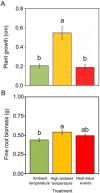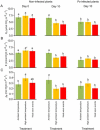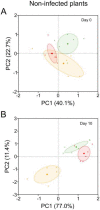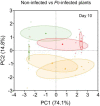Warming Scenarios and Phytophthora cinnamomi Infection in Chestnut (Castanea sativa Mill.)
- PMID: 36771639
- PMCID: PMC9921032
- DOI: 10.3390/plants12030556
Warming Scenarios and Phytophthora cinnamomi Infection in Chestnut (Castanea sativa Mill.)
Abstract
The main threats to chestnut in Europe are climate change and emerging pathogens. Although many works have separately addressed the impacts on chestnut of elevated temperatures and Phytophthora cinnamomi Rands (Pc) infection, none have studied their combined effect. The objectives of this work were to describe the physiology, secondary metabolism and survival of 6-month-old C. sativa seedlings after plants were exposed to ambient temperature, high ambient temperature and heat wave events, and subsequent infection by Pc. Ten days after the warming scenarios, the biochemistry of plant leaves and roots was quantified and the recovery effect assessed. Plant growth and root biomass under high ambient temperature were significantly higher than in plants under ambient temperature and heat wave event. Seven secondary metabolite compounds in leaves and three in roots were altered significantly with temperature. Phenolic compounds typically decreased in response to increased temperature, whereas ellagic acid in roots was significantly more abundant in plants exposed to ambient and high ambient temperature than in plants subjected to heat waves. At recovery, leaf procyanidin and catechin remained downregulated in plants exposed to high ambient temperature. Mortality by Pc was fastest and highest in plants exposed to ambient temperature and lowest in plants under high ambient temperature. Changes in the secondary metabolite profile of plants in response to Pc were dependent on the warming scenarios plants were exposed to, with five compounds in leaves and three in roots showing a significant 'warming scenario' × 'Pc' interaction. The group of trees that best survived Pc infection was characterised by increased quercetin 3-O-glucuronide, 3-feruloylquinic acid, gallic acid ethyl ester and ellagic acid. To the best of our knowledge, this is the first study addressing the combined effects of global warming and Pc infection in chestnut.
Keywords: abiotic stress; biochemistry; climate change.
Conflict of interest statement
The authors declare no conflict of interest.
Figures








Similar articles
-
Choosing the right signaling pathway: hormone responses to Phytophthora cinnamomi during compatible and incompatible interactions with chestnut (Castanea spp.).Tree Physiol. 2025 Mar 3;45(3):tpaf016. doi: 10.1093/treephys/tpaf016. Tree Physiol. 2025. PMID: 39883087
-
Hormone and secondary metabolite profiling in chestnut during susceptible and resistant interactions with Phytophthora cinnamomi.J Plant Physiol. 2019 Oct;241:153030. doi: 10.1016/j.jplph.2019.153030. Epub 2019 Aug 26. J Plant Physiol. 2019. PMID: 31493717
-
Resistance to Phytophthora cinnamomi in American Chestnut (Castanea dentata) Backcross Populations that Descended from Two Chinese Chestnut (Castanea mollissima) Sources of Resistance.Plant Dis. 2019 Jul;103(7):1631-1641. doi: 10.1094/PDIS-11-18-1976-RE. Epub 2019 Apr 29. Plant Dis. 2019. PMID: 31033400
-
Current Biological Insights of Castanea sativa Mill. to Improve Crop Sustainability to Climate Change.Plants (Basel). 2025 Jan 23;14(3):335. doi: 10.3390/plants14030335. Plants (Basel). 2025. PMID: 39942897 Free PMC article. Review.
-
European and American chestnuts: An overview of the main threats and control efforts.Front Plant Sci. 2022 Aug 24;13:951844. doi: 10.3389/fpls.2022.951844. eCollection 2022. Front Plant Sci. 2022. PMID: 36092400 Free PMC article. Review.
Cited by
-
Potassium Phosphonate Induces Resistance in Sweet Chestnut against Ink Disease Caused by Phytophthora Species.Pathogens. 2023 Feb 22;12(3):365. doi: 10.3390/pathogens12030365. Pathogens. 2023. PMID: 36986287 Free PMC article.
-
An improved method to study Phytophthora cinnamomi Rands zoospores interactions with host.BMC Plant Biol. 2024 Jun 6;24(1):508. doi: 10.1186/s12870-024-05205-2. BMC Plant Biol. 2024. PMID: 38844843 Free PMC article.
-
Heat Stress and Plant-Biotic Interactions: Advances and Perspectives.Plants (Basel). 2024 Jul 23;13(15):2022. doi: 10.3390/plants13152022. Plants (Basel). 2024. PMID: 39124140 Free PMC article. Review.
References
-
- Elvira-Recuenco M., Cacciola S.O., Sanz-Ros A.V., Garbelotto M., Aguayo J., Solla A., Mullett M., Drenkhan T., Oskay F., Kaya A.G.A., et al. Potential interactions between invasive Fusarium circinatum and other pine pathogens in Europe. Forests. 2020;11:7. doi: 10.3390/f11010007. - DOI
-
- Lombardero M.J., Solla A., Ayres M.P. Pine Defenses against the pitch canker disease are modulated by a native insect newly associated with the invasive fungus. For. Ecol. Manag. 2019;437:253–262. doi: 10.1016/j.foreco.2019.01.041. - DOI
LinkOut - more resources
Full Text Sources

